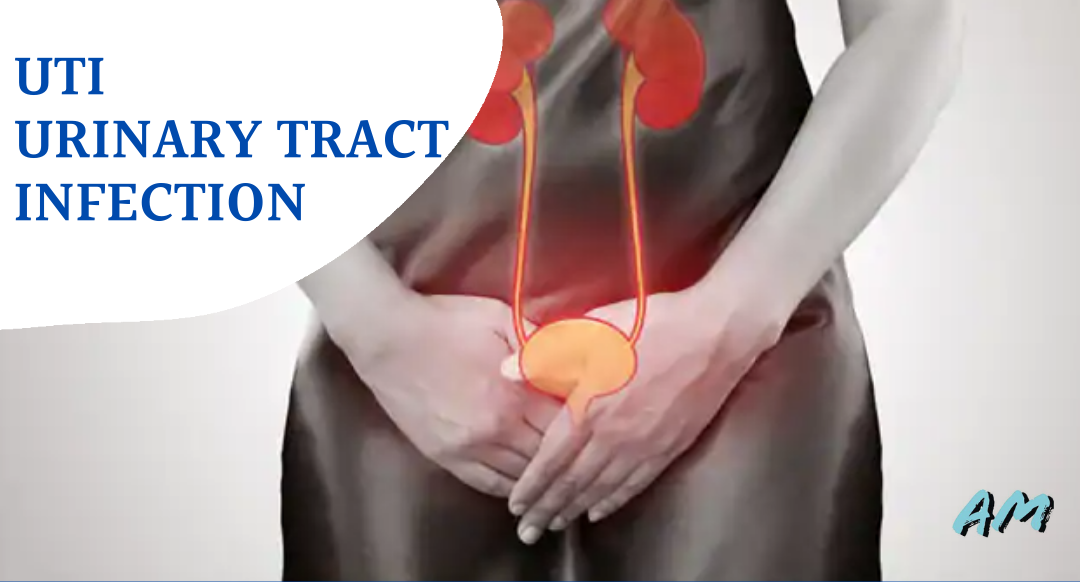A urinary tract infection (UTI) is an infection that affects part of the urinary System. The urinary system includes the kidneys, ureters, bladder, and urethra. Most infections involve the lower urinary tract (the bladder and the urethra). When it affects the lower urinary tract it is known as a bladder infection (cystitis) and when it affects the upper urinary tract it is known as a kidney infection. If an infection is limited to the bladder, it can be painful and annoying. But serious health problems can result if a UTI spreads to the kidneys.
ETIOLOGY
The commonest cause of UTI is of bacterial Origin, 70% to 90% of which is caused by E. Coli, other bacterial causes may include saprophyticus, Proteus species, Klebsiella species, Enterococcus faecalis. Fungal causes are Candida species or yeast infections.
UTIs typically occur when bacteria enter the urinary tract through the urethra and begin to spread in the bladder. Although the urinary system is designed to keep out bacteria, but the defenses sometimes fail which makes the bacteria to take hold and grow into a full-blown infection in the urinary tract. The most common UTIs occur mainly in women and affect the bladder and urethra.
Infection of the bladder: This type of UTI is usually caused by Escherichia coli (E. coli), a type of bacteria commonly found in the gastrointestinal (GI) tract. All women are at risk of bladder infections because the urethra is close to the anus and the urethral opening is close to the bladder making it easier for bacteria around the anus to enter the urethra and to travel to the bladder.
Infection of the urethra: This type of UTI can happen when gastrointestinal bacteria spread from the anus to the urethra. An infection of the urethra can also be caused by sexually transmitted infections such as herpes, gonorrhea, chlamydia and mycoplasma. This happens because women’s urethras are close to the vagina.
RISK FACTORS
- Women are at greater risk of developing a UTI than are men mainly due to the anatomy of the urinary tract in woman (they have shorter urethra, therefore shorter distance from external to the bladder).
- Pregnant and elderly woman are also at higher risk of UTI.
- Frequent Antibiotics exposure leading to multidrug resistance to treatment.
- Immunocompromised states e.g People with Diabetes Mellitus, HIV, Kidney stones, Multiple Schlerosis etc.
- History of instrumentation e.g Catheterization.
SYMPTOMS
UTIs don’t always cause symptoms but when they do, they may include:
- A strong urge to urinate that doesn’t go away
- A burning feeling when urinating
- Urinating often, and passing small amounts of urine
- Urine that looks cloudy or appears red, bright pink or cola-colored (signs of blood in the urine)
- Strong-smelling urine
- Feeling tired or shaky
- Fever or chills (a sign that the infection may have reached your kidneys)
- Pelvic pain in women, especially in the center of the pelvis and around the area of the pubic bone
TYPES OF UTIs
The types of UTI include the following depending on the part of the urinary tract affected:
- Cystitis (bladder): You might feel like you need to pee a lot, or feel pain when you pee. You might also have lower belly pain and cloudy or bloody urine.
- Pyelonephritis (kidneys): This can cause fever, chills, nausea, vomiting, and pain in your upper back or side. This is also classified as upper UTI
- Urethritis (urethra): This can cause a discharge and burning when you pee.
DIAGNOSIS
- Urinalysis: During this test, you’ll pee into a special cup and the provider will send the sample to a laboratory, where technicians will examine it for signs of a UTI using multiple variables such as nitrites, leukocyte esterase and white blood cells.
- Urine culture: Here, lab technicians will test your urine sample to grow and identify any bacteria that are present. Urine cultures are important because they help your provider determine the most appropriate treatment.
TREATMENT
The best thing to do for a urinary tract infection is to see a healthcare provider. Your provider will select an antibiotic that works best against the bacteria responsible for your infection. Healthcare providers commonly prescribe the following antibiotics to treat UTIs:
- Nitrofurantoin
- Sulfonamides (sulfa drugs), such as sulfamethoxale/trimethoprim.
- Amoxicillin
- Cephalosporins, such as cephalexin.
- Doxycycline
- Fosfomycin.
- Quinolones, such as ciprofloxacin or levofloxacin.
PREVENTION
The following lifestyle changes can help prevent urinary tract infections:
- Practice good hygiene: Practicing good hygiene is one of the best ways to help prevent UTIs. This is especially important for female as the urethra is much shorter, and it’s easier for E. coli to move from the rectum back into the body. So, always wipe from front to back after a bowel movement to avoid this. Regularly change your period products, including pads and tampons during menstrual period. Avoid using any deodorants on your vagina.
- Drink plenty of fluids: Drinking extra fluids especially water each day can help flush out bacteria from your urinary tract. Healthcare providers recommend drinking six to eight glasses of water daily.
- Change your peeing habits: Peeing can play a big role in getting rid of bacteria from your body. Your pee is a waste product, and each time you empty your bladder, you remove waste from your body. Peeing frequently can reduce your risk of developing an infection, especially if you get UTIs a lot. Try to pee right before and right after having sex because sex can introduce bacteria to your urethra. If you can’t pee, wash the area with warm water.
- Change your birth control: Some people have an increased risk of developing a UTI if they use a diaphragm for birth control. You can talk to a healthcare provider about other birth control options.
- Use a water-based lubricant during sex: If you use lubricant during sex, make sure it’s water-based. You should also avoid spermicide if you have frequent UTIs.
- Change your clothing: Tight-fitting clothing can create a moist environment, which promotes bacterial growth. Try loose-fitting clothing and cotton underwear to prevent moisture from accumulating around your urethra.
- Medications: If you’re postmenopausal, a healthcare provider may suggest a vaginal cream that contains estrogen. These creams may help reduce your risk of developing a UTI by changing the pH of your vagina.
REFERENCE
- “Urinary Tract Infection”. Centers for Disease Control and Prevention (CDC). 17 April 2015. Archived from the original on 22 February 2016. Retrieved 9 February 2016.
- Lane DR, Takhar SS (August 2011). “Diagnosis and management of urinary tract infection and pyelonephritis”. Emergency Medicine Clinics of North America. 29 (3): 539–552. doi:10.1016/j.emc.2011.04.001. PMID 21782073.
- Urinary Tract Infection (UTI) and Cystitis (Bladder Infection) in Females. Emedicine.medscape.com

